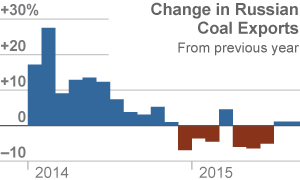Russia’s Dream of Coal-Export Expansion Is at Risk

 Warning signs litter the Russian coal-industry landscape, with export trends dipping into the red recently, demand from China plummeting and renewable electricity fast becoming a preferred source of new power.
Warning signs litter the Russian coal-industry landscape, with export trends dipping into the red recently, demand from China plummeting and renewable electricity fast becoming a preferred source of new power.
Even so, the Russian government seems determined to press ahead with policies and investments aimed at expanding coal exports and domestic coal-fired power production. How far will they get? It depends perhaps on China.
While two-thirds of Russia’s coal production is consumed domestically, it is the world’s third largest coal exporter (120 million tons of thermal coal and 220 million tons of metallurgical coal in 2014), even with its many huge logistical challenges.
Coal from the Kuznetsk Basin in central Russia—where over half the country’s coal is mined—has to be transported almost 4,200 kilometers (2,600 miles) to reach Europe. Asian markets are even further away. Because of these distances, even with transport on publicly-subsidized Russian Railways—coal from Russia has been at a competitive disadvantage to other exporters. Russia is responding by building major coalfields in eastern Siberia and beyond, with the hope that such regions can be developed into export feeders to China.
SO RUSSIAN BOOM-TIME PLANS PERSIST EVEN IN THE FACE OF HARSH MODERN ENERGY-MARKET REALITIES AND EVIDENCE THAT NO SUCH BOOM IS IN THE MAKING. These projects are in a sparsely populated, cold region with limited transport and port infrastructure, and China’s appetite for coal imports is waning.
The Russian government is also predicting domestic coal consumption will increase by almost one-third by 2030 and is planning significant expansion of new coal plants near the border with China so that power can be exported. The most prominent of these projects is the proposed 8000-megawatt Erkovetskaya power plant, a joint venture by the Russian company Inter RAO and State Grid Corp. of China. It would be the largest coal plant in the world, and would have a price tag of up to $25 billion, and require a 2,000-kilometer (1,242-mile) transmission line to connect it to the Chinese grid.
The government is hoping that by 2030 coal exports will have grown by 45 percent, reaching 170 million tons. While the bulk of the estimated expansion is expected to be for thermal coal, government planners are counting on more than a tripling of the higher-priced metallurgical coal, which is used mostly in steel making. Two new ports with a combined capacity of 40 million tons per year are planned in the Primorsky region on the Russian Pacific coast near the border with China. However, these proposed terminals, at Vera Port and Sukhodol Bay, are facing uncertainty due to recent federal budget cuts, and their development will likely hinge on international funding. While the Vera Port project has Korean Western Power (KowepoI) and China Shenhua Energy Co. as joint-venture partners, the Sukhodol project is said to be lacking any international investor of substance.
So the dream of a bigger Russian place in Asian markets faces considerable challenges that include the recent and dramatic collapse of Chinese thermal coal import demand and the rise of renewables. Even Tigers Realm Coal’s proposed metallurgical coal mines in the Russian Arctic, which is close to the coast with access to an existing export terminal, is floundering (“A Russian Arctic Coal Dream Fades”).
Still, Inter RAO this year signed a memorandum of understanding with a provincial government in Vietnam for the development of the 1,200-megawatt Quang Trach power plant. And Russian Railways is exploring the feasibility of exporting Siberian coal to South Korean via the recently-upgraded Rajin port in North Korea and has entered into an agreement with Thailand’s Banpu Public Co. for the development of a coal railway and export terminal on the Indonesian island of Borneo.
One of the clear-eyed realists may turn out to be Prime Minister Dmitry Medvedev, who in a draft national energy strategy through 2035 earlier this year noted that “easy money will be harder to come by” and hinted at the risk of stranded assets in Russia’s coal industry.
“Energy revolutions,” Medvedev said, “come around every fifty to sixty years, bringing new types of fuel, which ultimately changes the playing field.”
Bob Burton is the editor of CoalWire.














